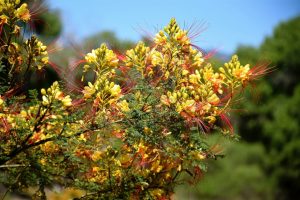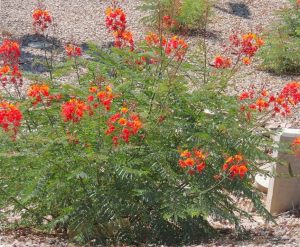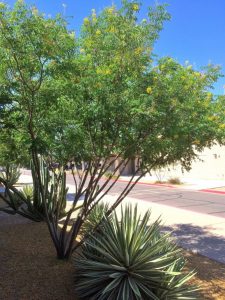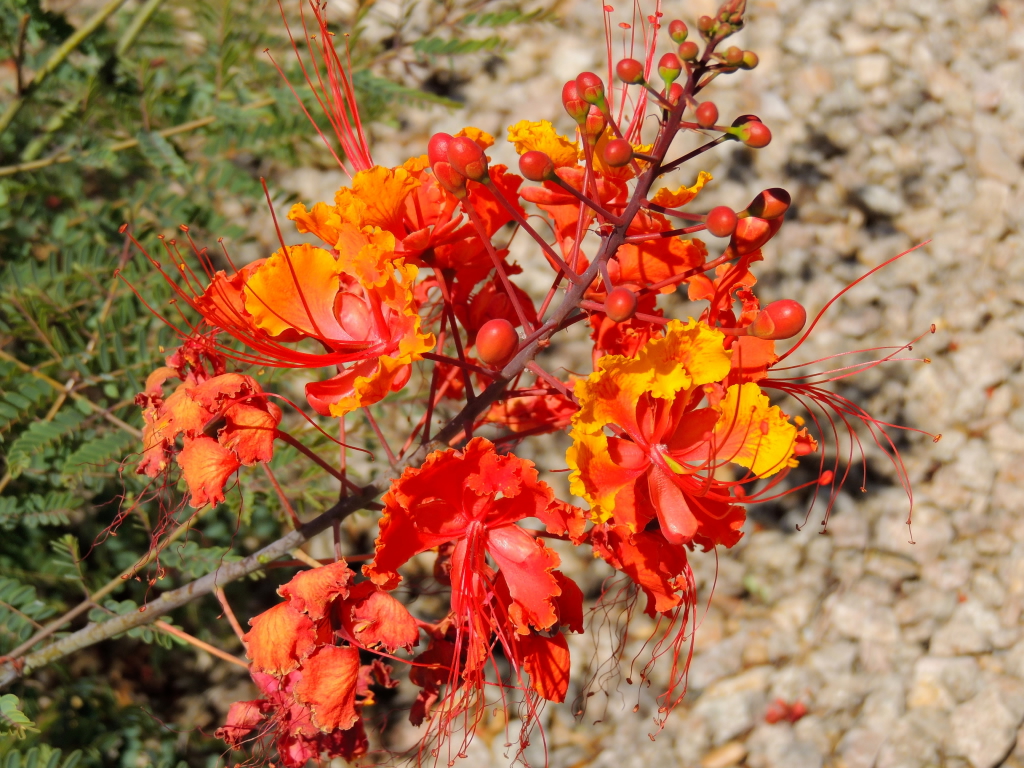Caesalpinias make the landscape come alive with color. Their large bright flowers provide vibrant color for long periods of time. The shades of yellow, fiery red, and orange contrast with the feathery foliage.
Commonly called bird of paradise, they range in size from medium shrubs to small trees. They thrive in the desert heat and can survive on little supplemental irrigation. Provide deep watering every two weeks while blooming in order to prolong flowering and keep plants healthy.
Bird of paradise is tolerant of most soil conditions but prefers well drained soils. Chlorosis can occur in heavy soils but is easily treated with iron chelate. The deciduous varieties can be pruned back severely during late winter when they are dormant, and new growth will occur in the spring. This pruning will also keep the form more round and compact. The seed pods should not be eaten. All of these species do a great job of attracting butterflies and hummingbirds.

Caesalpinia gilliesii, Desert/Yellow Bird of Paradise
This bird of paradise produces large clusters of yellow flowers with long red stamens. It is generally open in form with a slender trunk and medium green leaflets. The spring to summer bloom is followed by 4 to 5 inch seed pods. Yellow bird of paradise is usually deciduous except in the warmest areas, but seldom looks its best during the winter. It reaches a height of 6 to 10 feet and a spread of 4 to 6 feet at maturity. Yellow bird of paradise makes an excellent accent plant in either the tropical or desert landscape. They reseed themselves, and can produce litter if seed pods are not pruned off before they fall.

Caesalpinia pulcherrima, Red Bird of Paradise
The red bird of paradise is not as cold hardy as yellow bird of paradise. The summer blooms of orange and yellow flower clusters add a vibrant accent to the landscape. This vase shaped shrub thrives in the hottest areas of the landscape, blooming throughout the warm season. Once roots are established, cut the stems back to the ground in the winter. Foliage turns a nice red color in the cold, so you can also leave stems through the winter and trim in early spring. Established, untrimmed plants can reach a height of over 6 feet. The flower clusters are followed by 3 to 6 inch seed pods.
This variety makes an excellent accent plant, providing a super show of color throughout the summer. It requires good drainage to perform at its best.

Caesalpinia mexicana, Mexican Bird of Paradise
The Mexican bird of paradise’s lush, deep foliage sets it apart. It is evergreen in warm protected areas of the landscape. Mexican bird of paradise produces bright yellow flower clusters throughout the warm season. Mexican bird of paradise can easily be pruned into a small tree. Its mature height can reach 8 to 10 feet with similar spread.
Mexican bird of paradise requires full sun to keep it full and dense. It makes an excellent accent and oasis plant for tropical, natural or desert landscapes. Water every 2 weeks while blooming with little or no supplemental watering required during other times. Prune in early spring to shape and control growth.
Did you know that up to 70% of water use is outdoors? That’s why we love desert plants and feature them each month. It’s still a great time to plant, and you can learn more about Caesalpinia’s and other plants on our Arizona Low-Water-Use Plants page. Visit our page on Choosing and Planting Low Water-Use Plants for tips on plant selection and how to plant properly. Also, be sure to read through all of our featured Plant of the Month blogs!
This feature is based on a concept and text originally developed jointly by the Arizona Nursery Association and the Arizona Municipal Water Users Association (AMWUA) with partial funding from the Arizona Department of Water Resources. Learn more about these and other great desert plants at the Arizona Municipal Water Users Association Landscape Plants for the Arizona Desert plant database.


